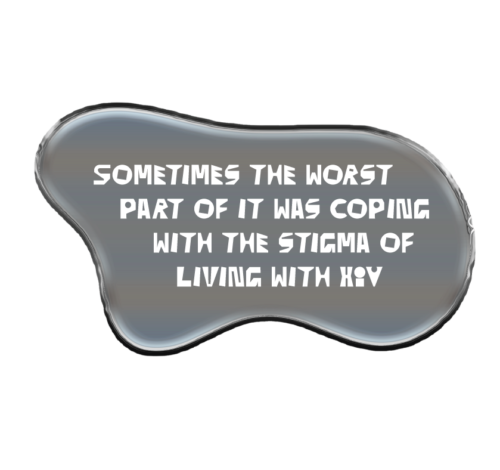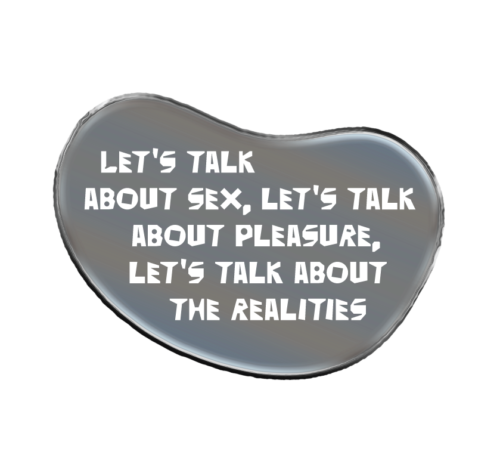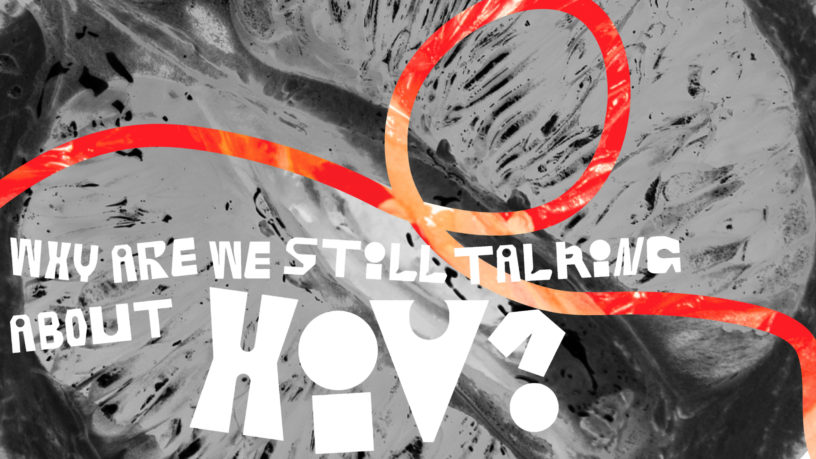Words by Rowan Flood
Visuals by Brithi Sehra & Jerry Zhang
“It’s harsh. It happens quickly,” says Elaine Ruiz*, a third-year media production student. “Without warning.”
In 2019, Ruiz had someone close to her pass away from an acquired immunodeficiency syndrome (AIDS)-related illness. It happened within a couple of months. He was in his 20s, living with her and her family in China. Ruiz explains he had many passions; he loved animals and travel and was driven to learn Mandarin. She couldn’t remember why he was so motivated to learn the language, but he was. However, he couldn’t even leave the house shortly after his arrival. He got thin and couldn’t consume food or water.
“He just got really sick,” Ruiz says over Zoom as a slight coarseness enters her voice. “We had no idea why.”
Before this experience, AIDS seemed like a faraway “tale” for her.
Undetectable = Untransmittable (U = U), Pre-exposure prophylaxis (PrEP), Viral Load, Antiretroviral therapy (ART), are terms that people living with human immunodeficiency virus (HIV) and those in communities with a higher risk of contracting it are familiar with— terms they must know well. However, it’s a language unheard of for others.
Even the meaning and difference between HIV and AIDS must be understood, Dr. Trevor Hart, director of the HIV Prevention Lab and Toronto Metropolitan University’s (TMU) new HOPE Centre for Gender and Sexual Minority People explains.
“Most people with HIV nowadays, as long as they’re taking medication, they’ll never get to AIDS,” Hart says. But according to the Centre for Disease Control and Prevention, if left untreated HIV, can lead to AIDS.
Hart says even people who have at some point had an AIDS diagnosis can be healthy now. Further, he says even when someone is sick from HIV, their symptoms may not meet the criteria for AIDS.
U = U means someone with HIV will have an undetectable viral load, an amount of the virus in their blood, that makes successfully transmitting the virus sexually impossible. PrEP is a medicine that prevents HIV, and ART is a treatment that doesn’t cure but allows people with HIV to live healthy, long lives.
Although the World Health Organization claims approximately 76 per cent of people living with HIV globally in 2022 were accessing treatment, they live with much more than a physical illness.
The stigma surrounding the virus is just as harmful, if not more, as living with it, says Hart over the phone.
Hart explains people living with HIV fear judgement, having often been told something is wrong with them. They’re labelled as ‘bad,’ even though they’re engaging in something that’s as natural as sex.
Hart believes some people are unaware HIV is still around. But transmissions still occur, and people are still dying from AIDS-related illnesses. Statistics from UNAIDS show that about 39 million people globally were living with HIV in 2022, and around 1.3 million people became newly infected with HIV in the same year.
Many TMU students remain largely misinformed about sexual health, particularly about one of the most stigmatized areas —HIV and AIDS. From a lack of sexual health education in high school to shame around STIs, including HIV, students are entering university unfamiliar with the realities of a virus that continues to impact millions of people. According to CATIE, Canada’s leading information source on AIDS, HIV and hepatitis C, for every 100,000 people nationwide, 170 of them are living with HIV.
Improved sexual education can decrease stigma and misconceptions about HIV. Hart attests that sex education must “include a discussion of HIV, how you get it and how you can avoid getting it.” Further, Hart says people should understand that those living with HIV who take their medication and maintain an undetectable viral load cannot transmit HIV, a common misconception about people living with the virus.
Many people living with HIV or knowledgeable about the virus express that HIV education creates a safer environment for everyone, no matter their status.

When Aaron Clarke, the gay men’s community education & resource coordinator at the AIDS Committee of Toronto (ACT), was first diagnosed with HIV, he spent a couple of nights sleeping on the floor. He didn’t want his partner to touch him, or share a bed with him. His thoughts ranged from something is wrong with me, I’m stupid, to I let this happen to me. His mental and sexual health both took a hit.
“I wasn’t interested in having sex whatsoever,” Clarke says.
Hart has worked with people living with HIV for many years who’ve had similar feelings to Clarke. During his graduate studies, Hart trained as a clinical psychologist and worked at a community centre for sexual and gender minority youth. He began to identify common feelings amongst people he worked with and himself.
“They had a lot of shame and fear,” Hart says.
Hart explains people with HIV worry about being judged and treated poorly. Hart recognizes that he wants to help people not only cope with the medical side of their diagnosis but the mental impact too.
“Sometimes the worst part of it was coping with the stigma of living with HIV,” Hart says, referring to the youth he worked with.

“People are often told who are living with HIV, ‘What did you do wrong?’” Hart says. He clarifies that often the people accusing them of “doing something wrong” are engaging in the same behaviour: having anal or vaginal sex without a condom—“how most of us in the world are made.”
Hart adds, “In reality, the people that are contracting HIV are having sex…Doing what most people on campus are doing.”
elp people who were HIV-negative stay negative and help those with HIV resist the stigma and live full and happy lives.
An online survey by the Canadian Foundation for AIDS found that the majority of youth ages 12 to 25—at least six in 10—consistently disagreed or strongly disagreed that they would date, kiss or share utensils with someone living with HIV. Further, the study, with 431 responses, showed that 44.6 per cent disagreed or strongly disagreed that they would be friends with someone who has HIV.
“The way to combat that [stigma], I think, is through better sex education,” Hart says.
Hart explains that while HIV stigma primarily comes from HIV-negative people, the education must also be for people living with HIV.
“You can’t get HIV through sharing a drinking glass. You can’t get HIV if someone serves you a meal,” Hart explains. “You can’t get it from hugging them.”
Samantha DeFranco, the coordinator for the Centre for Safer Sex and Sexual Violence Support (C3SVS), constantly works with students whose lack of HIV knowledge “kind of scares” her, she says with a laugh.
“Most students know it exists but that’s kind of the baseline,” DeFranco says over Zoom.
While some students come looking for help with things such as PrEP and have more knowledge about what they’re looking for, she says many still have inaccurate information about HIV, such as it being a “gay disease.” However, numbers from the Centers for Disease Control and Prevention show that in 2021, in the United States, 22 per cent of new HIV infections were from people who reported heterosexual contact.
Simply put, she sees a lack of awareness but also of conversation.
“We don’t talk about stigma. We don’t talk about what it is like to be living with HIV,” DeFranco says.
DeFranco sees that students don’t have proper sexual health education in high school and tend not to have those conversations with parents either. She worries that the average student would not know how to support a friend with an HIV diagnosis and may even say something harmful.
C3SVS does offer an HIV workshop one to two times a year. Part of the workshop involves an online survey where students answer questions. DeFranco says almost everyone gets the “What does U = U mean?” question wrong. To create engaging conversations, the workshops often have games, food and word puzzles, in an effort “to make it an experience,” rather than a lecture, she says.
“Let’s talk about sex, let’s talk about pleasure, let’s talk about the realities,” DeFranco says.
Multiple TMU students express having minimal sexual education in high school.


AAlex Sorichetti is a fourth-year sport media student who, after Grade 9, “got just about nothing” for sexual health education. While that seems minimal, Sorichetti considers himself lucky to have had a gym teacher who provided two weeks’ worth of “health” education.
DeFranco believes that there are a considerable amount of sex education teachers who got their own education decades ago and may even be teaching in a way that further stigmatizes sex by making it seem scary or bad. The Ontario Curriculum for grades 9 to 12 includes brief education on HIV and AIDS prevention and the curriculum for grades 1 to 8 mentions education on sexually transmitted and blood borne infections (STBBIs) but does not specify HIV.
His former French gym teacher was direct. “’I’m just going to tell you blatantly, flat out, some things that you need to be concerned about and watch for and destigmatize,’” Sorichetti recalls the teacher saying. Sorichetti describes his teacher as “the nicest guy” who would always answer students’ questions.
One day, HIV and AIDS were mentioned during a class that focused on sexually transmitted diseases. After the discussion, Sorichetti recalls students looking around the room, wondering if someone had asked him about it. Post-class led to gossip, “Who asked, why did they ask, do they have it?” he says students wondered.
Sorichetti says his knowledge of HIV and AIDS is enough to know it can affect anyone, there is no cure and “it’s not a death sentence.” However, he feels that’s pretty much where his knowledge ends.
Logan Onate is a second-year child and youth care student who, similar to Sorichetti, got their main bit of sexual education in Grade 9 gym. They explain that the focus was mainly on contraception and they well remember the “wooden penis” that people got to practice putting condoms on.
They explain that what they know about HIV comes from the media and their sex and gender identity class at TMU but also their experiences being a Queer person. Their hands jump onto the screen over Zoom, expressively swaying as they describe a recent incident at work.
While working a regular shift at a downtown dispensary, a man came in, “rambling outspoken, out-of-pocket” things. Their hands point firmly at the camera on Zoom as they describe how the man looked at them and said, “You have AIDS” before he left.
They quickly retract from the camera, eyes wide, as they relive the scenario. They explain that as a Queer person, people still have assumptions about them and they believe there is still a lingering vilification of Queer folks.
They finish recalling the incident with an airy laugh of disbelief.
Things began to change once Clarke was on medication and became undetectable for HIV. It allowed him to be comfortable in his skin again. HIV also changed his life by connecting him to ACT.
He became aware of ACT when he was diagnosed with HIV and connected with one of their counsellors with whom he is now colleagues. His cheerful demeanour shines through the Zoom screen as he smiles widely, telling his “from rags to riches” story, adding “even though I’m not rich” with a laugh.
Clarke understands the difficulties that come with living with HIV but he also understands the importance of being sexually informed. “If you’re curious about your sexual health and you want to be on top of it, go get tested,” Clarke says firmly, nodding his head with each word.
Though, Clarke says even getting tested can come with its own set of difficulties. People may question why you think you need an HIV test and assume things about your sexuality or drug use or that you’re a “messy slut.”
“That’s not necessarily a bad thing. You can be a messy slut and still protect yourself and protect others,” Clarke says with a smirk.
C3SVS offers HIV testing and take-home testing kits. DeFranco explains that staff are trained to help those coming in for tests. She knows people may be scared and staff are equipped to suggest support groups and other resources while being prepared to take on generations of misinformation.
Similar to DeFranco, Clarke believes some people continue to associate HIV with being ‘gay only.’
In the early 80s, AIDS was often referred to as Gay-Related Autoimmune Disease (GRID), which, as the SF LGBT Center says, created an enduring association between gay men and AIDS. The SF LGBT Center explains that the term AIDS became used when researchers understood it could impact everyone, not just men who have sex with other men.
Even today, language and word use around HIV continue to be worked on. Part of how ACT works to combat HIV stigma is being deliberate with their use of language as there continues to be negative vocabulary associated with it, Clarke explains.
Sorichetti says he’s heard the words “dirty,” “unsafe,” “tainted” and “dumb” associated with HIV. Words shape people’s understanding of the world and can impact how people see those living with HIV, explains The Well Project on their website, a non-profit organization aimed at supporting women living with or vulnerable to HIV.

MMyles Sexton is an HIV advocate based in Toronto with many passions, from blogging to modelling to fashion. Sexton goes after their dreams, moving to Toronto on their 19th birthday from a small town in Nova Scotia, partly chasing their “fashion bug.” However, more than a love of fashion pushed them to move.
“I needed to be in a space where I felt like I could fully be myself and be around other people that were like me,” Sexton says over Zoom as sparkling earrings and silver rings shine through the screen as they speak.
In 2018 Sexton received a phone call from their doctor telling them they had HIV. Sexton was 26 at the time and they thought they were going to die.
Their fear took a while to subside as it took around a month to see a specialist.
Sexton explains that the main exposure they had to HIV was from the AIDS epidemic. Images of people in the hospital, open sores and purple bruising were what they say came to mind.
Relief came when they spoke to a specialist and understood they could go on medication and become undetectable. However, physically getting better was only one part of their healing journey. “I just didn’t feel like the same person anymore. I felt like I was altered or changed and I had to figure out who I was again,” Sexton says.
Sexton says they had to do a lot of emotional labour and educate others when they were telling people about their diagnosis. When telling their family, not many even knew what HIV really was.
Sexton explains they felt vulnerable when getting their diagnosis and when looking for comfort from others changed to having to educate them, which prevented a level of safety. “It made me not want to open up to people about it,” Sexton says.
Sexton did get to a point where they felt ready to be public about their diagnosis, “reclaiming,” their power after two years of letting stigma and shame “sort of navigate my life.”
Despite losing someone close to her to an AIDS-related illness, Ruiz thinks there’s still more to be learned. She doesn’t talk about it with friends or family. She sometimes even questions what her parents think about Queerness. When the person close to them passed, she remembers her parents asking many questions like, “Where did he get it?” and “How did it happen?” Her parents only discussed it with the older people at the time, leaving Ruiz, the youngest, without support.
What she does have is the memory of him.
“I always felt comfortable being around him,” she says. They were both Queer, and at the time when he was staying with her family, she wasn’t out to her parents but she did have a girlfriend. He got to see that part of her life, she could talk to him about it—and he got to meet her girlfriend.
* Due to privacy concerns, this verified source has requested anonymity.












Leave a Reply